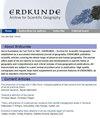Object-based mapping and classification features for tropical highlands using on Sentinel-1, Sentinel-2, and GEDI canopy height data - A case study of the Muringato catchment, Kenya
IF 1.1
4区 社会学
Q3 GEOGRAPHY
引用次数: 0
Abstract
Tropical highlands remain a challenging target for remote sensing due to their high heterogeneity of the landscape and frequent cloud cover, causing a shortage of high-quality and reliable comprehensive data on land use and land cover on a local or regional scale. These, however, are urgently needed by local stakeholders and decisionmakers. This applies for example to the Muringato sub-catchment in Nyeri County, Kenya, where acute water problems have been identified to be usually directly related to specific land use and land cover. This article contributes to the understanding of tropical highlands from a remote sensing perspective by examining Sentinel-1, Sentinel-2 and Global Forest Canopy Height Model data from the Global Ecosystem Dynamics Investigation, all provided by the Google Earth Engine. To do so, we assess classifiers derived from these datasets for different land cover types, analyzing the performance of promising candidates identified in the literature, using 2,800 samples extracted from high-resolution image data across Nyeri County. We also propose an object-based classification strategy based on sequential masking. This strategy is adapted to very heterogeneous landscapes by refining image objects after re-evaluating their homogeneity. Small buildings, which constitute a significant part of the settlement structure in the area, are particularly difficult to detect. To improve the recognition of these objects we additionally consider the local contrast of the relevant classifier to identify potential candidates. Evaluating our sample data, we found that especially optical indices like the Sentinel Water Index, the Enhanced Normalized Difference Impervious Surfaces Index or specific Sentinel-2 bands combined with canopy height data are promising for water, built-up or tree cover detection. With these findings, our proposed object-based classification approach is applied to the Muringato sub-catchment as a representative example of the Kenyan tropical highland region. We achieve a classification accuracy of approximately 88% in the Muringato sub-catchment, outperforming existing products available for the study area. The knowledge gained in the study will also be used for future remote sensing-based monitoring of the region.基于Sentinel-1、Sentinel-2和GEDI冠层高度数据的热带高地基于对象的地图绘制和分类特征——肯尼亚穆林加托流域的案例研究
热带高地仍然是一个具有挑战性的遥感目标,因为其景观高度异质性和频繁的云层覆盖,导致缺乏高质量和可靠的地方或区域尺度的土地利用和土地覆盖综合数据。然而,这些是当地利益攸关方和决策者迫切需要的。例如,这适用于肯尼亚尼耶里县的穆林加托分集水区,在那里已查明严重的水问题通常与具体的土地利用和土地覆盖直接有关。本文通过分析由谷歌Earth Engine提供的来自全球生态系统动力学调查的Sentinel-1、Sentinel-2和全球森林冠层高度模型数据,有助于从遥感角度理解热带高地。为此,我们评估了来自这些数据集的不同土地覆盖类型的分类器,分析了文献中确定的有希望的候选分类器的性能,使用了从Nyeri县的高分辨率图像数据中提取的2800个样本。我们还提出了一种基于顺序屏蔽的基于对象的分类策略。这种策略通过重新评估图像对象的同质性后对其进行细化,适用于非常异构的景观。构成该地区沉降结构重要组成部分的小型建筑物特别难以探测。为了提高对这些目标的识别,我们还考虑了相关分类器的局部对比来识别潜在的候选对象。通过对样本数据的评估,我们发现Sentinel Water Index、Enhanced Normalized Difference Impervious Surfaces Index或特定的Sentinel-2波段与冠层高度数据相结合的光学指数对于水、建筑或树木覆盖的检测很有希望。有了这些发现,我们提出的基于对象的分类方法应用于作为肯尼亚热带高地地区代表性例子的穆林加托子集水区。我们在Muringato子集水区实现了约88%的分类准确率,优于研究区域现有的产品。在这项研究中获得的知识也将用于今后对该区域的遥感监测。
本文章由计算机程序翻译,如有差异,请以英文原文为准。
求助全文
约1分钟内获得全文
求助全文
来源期刊

Erdkunde
地学-自然地理
CiteScore
2.00
自引率
7.10%
发文量
17
审稿时长
>12 weeks
期刊介绍:
Since foundation by Carl Troll in 1947, ''ERDKUNDE – Archive for Scientific Geography'' has established as a successful international journal of geography. ERDKUNDE publishes scientific articles covering the whole range of physical and human geography. The journal offers state of the art reports on recent trends and developments in specific fields of geography and comprehensive and critical reviews of new geographical publications. All manuscripts are subject to a peer-review procedure prior to publication. High quality cartography and regular large sized supplements are prominent features of ERDKUNDE, as well as standard coloured figures.
 求助内容:
求助内容: 应助结果提醒方式:
应助结果提醒方式:


